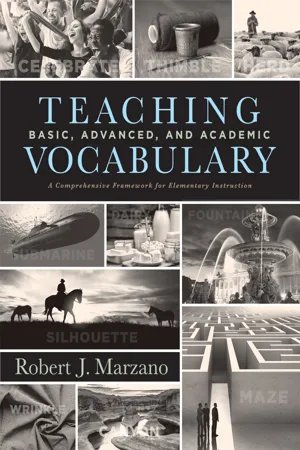
- 304 pages
- English
- ePUB (mobile friendly)
- Available on iOS & Android
Teaching Basic, Advanced, and Academic Vocabulary
About This Book
Construct a strong foundation for literacy development and academic achievement. Based on a robust analysis of high-frequency words, Dr. Robert J. Marzano identifies more than 8, 000 basic, advanced, and academic vocabulary terms for grades K–5. The terms are organized into 444 semantic clusters, which have been carefully curated to provide a rich semantic context for students and aid their learning.
Use this resource to help students learn a tiered vocabulary and close the achievement gap in education.
- Understand the importance of students having strong foundational vocabulary and its effect on academic achievement.
- Learn the cluster approach to vocabulary instruction and how it helps students gradually learn the unique features of terms.
- Gain 420 word clusters specific to basic (tier one) and advanced (tier two) terms, and obtain a diagnostic assessment tool to identify where students fall on the cluster continuum.
- Discover how to utilize a six-step process when teaching academic (tier three) terms.
- Ascertain the benefit of having a coordinated schoolwide plan for vocabulary instruction, including early literacy development.
- Learn strategies for teaching students who require individualized assistance, such as students from poverty and English learners.
- Access an online vocabulary tool, as well as a student notebook designed to help learners track their progress with semantic clusters.
-
Contents:
Introduction: The Importance of Vocabulary Knowledge
Chapter 1: Teaching and Reinforcing Tier One and Tier Two Terms as a Schoolwide Effort
Chapter 2: Tier One and Tier Two Terms for Individual Students
Chapter 3: Teaching Tier Three Terms
Appendix A
Appendix B: Hardcopy Diagnostic Assessment
Appendix C
References and Resources
Index
Frequently asked questions
Information
Table of contents
- Cover
- Title Page
- Copyright
- Table of Contents
- About the Author
- Introduction: The Importance of Vocabulary Knowledge
- Chapter 1: Teaching and Reinforcing Tier One and Tier Two Terms as a Schoolwide Effort
- Chapter 2: Tier One and Tier Two Terms for Individual Students
- Chapter 3: Teaching Tier Three Terms
- Appendix A
- Appendix B: Hardcopy Diagnostic Assessment
- Appendix C
- References and Resources
- Index